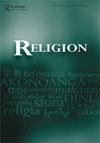生态美学:动物精神在当代科学、哲学和文学中的形象
IF 1
2区 哲学
0 RELIGION
引用次数: 0
摘要
【摘要】黛博拉·伯德·罗斯用土著约尔恩古语bir 'yun——闪光——来描述体验大自然祖先和持续力量的内在能力。以罗斯的概念为主题,本文研究了动物精神在当代科学、哲学和文学边缘的当代形象。我的论点以德勒兹和瓜塔里(Citation1987)的哲学尝试为基础,通过使用象征性、盖亚、全息生物和无器官的身体(BwO)等成为形象,通过成为动物/成为强烈的概念来颠覆教条的人类中心主义思想形象。从探索科学如何开始通过动物组合的新形象来推翻自己对动物的机械论观点开始,文章转向一个文学例子——罗伯特·霍尔德斯托克的《拉文德西斯》(Citation1988)——来研究我们如何着手解决成为动物组合的本质,以重新获得微光作为生态美学实践的经验。关键词:shimmergaiaholiont组装;对称性;变动物;变强烈(或如何建立一个没有器官的身体);推翻人类中心主义的自负披露声明作者未报告潜在的利益冲突。delphi Carstens delphi Carstens是西开普省大学文学院的讲师,对生态美学、德勒兹-瓜达里亚理论和人类世研究感兴趣。他在新唯物主义哲学、环境正义教学法、神秘科幻小说、神话创造以及性别和动物研究方面发表了大量文章,最近与尚特尔·格雷合著的《南方的SOTL》(1)。本文章由计算机程序翻译,如有差异,请以英文原文为准。
Ecological aesthesis: figurations of the animal spirit in contemporary science, philosophy and literature
ABSTRACTDeborah Bird Rose uses the Aboriginal Yol’ngu term bir’yun – shimmer – to describe the inherent capacity to experience nature’s ancestral and ongoing power (Citation2022). Using Rose’s concept as a leitmotif, this article investigates contemporary figurations of the animal spirit as it moves through the margins of contemporary science, philosophy, and literature. Using becoming figurations like sympoiesis, Gaia, the holobiont, and the Body without Organs (BwO), my argument is underpinned by Deleuze and Guattari’s (Citation1987) philosophical attempts to subvert the dogmatic anthropocentric image of thought via becoming-animal/becoming-intense concepts. Beginning with an exploration of how science is beginning to overturn its own mechanistic view of the animal via new figurations of the animal assemblage, the article turns to a literary example – Robert Holdstock’s Lavondyss (Citation1988) – to examine how we might go about addressing the nature of the becoming-animal assemblage to recapture the experience of shimmer as an ecologically aesthetic praxis.KEYWORDS: ShimmerGaiaholobiont assemblagessympoiesisbecoming-animalbecoming-intense (or how to build a body without organs)overturning the anthropocentric conceit Disclosure statementNo potential conflict of interest was reported by the author(s).Additional informationNotes on contributorsDelphi CarstensDelphi Carstens is lecturer in the Faculty of Arts at the University of the Western Cape with an interest in ecological aesthetics, Deleuze-Guattarian theory and Anthropocene studies. He has published widely on new materialist philosophies, environmentally-just pedagogies, uncanny science fictions, and mythopoiesis, as well as gender and animal studies, most recently with Chantelle Gray in SOTL in the South 7(1).
求助全文
通过发布文献求助,成功后即可免费获取论文全文。
去求助
来源期刊

RELIGION
RELIGION-
CiteScore
2.70
自引率
0.00%
发文量
58
期刊介绍:
RELIGION is an internationally recognized peer-reviewed journal, publishing original scholarly research in the comparative and interdisciplinary study of religion. It is published four times annually: two regular issues; and two special issues (or forums) on focused topics, generally under the direction of guest editors. RELIGION is committed to the publication of significant, novel research, review symposia and responses, and survey articles of specific fields and national contributions to scholarship. In addition, the journal includes book reviews and discussions of important venues for the publication of scholarly work in the study of religion.
 求助内容:
求助内容: 应助结果提醒方式:
应助结果提醒方式:


